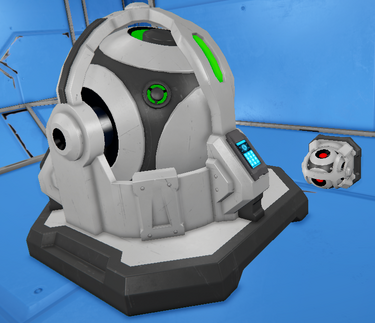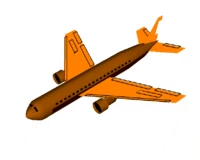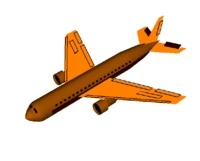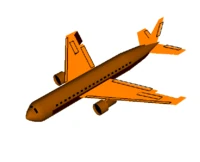Function[]
The addition of a ![]() Gyroscope to a ship will allow it to rotate in place around any of its three axes, around its center of mass. The rotation is called pitch, roll, or yaw, depending on the axis.
Gyroscopes also play a key part in stabilization of a ship (or rover, or walker), even keeping it stable even when no one is manning the cockpit.
Gyroscope to a ship will allow it to rotate in place around any of its three axes, around its center of mass. The rotation is called pitch, roll, or yaw, depending on the axis.
Gyroscopes also play a key part in stabilization of a ship (or rover, or walker), even keeping it stable even when no one is manning the cockpit.
Note that the ship must have enough power and Inertial Dampers must be switched on for ship gyroscopes to work as expected.
Mass[]

The more mass a ship has, the more Gyroscopes are needed to achieve the same amount of turning sensitivity.
The placement of gyros can also matter, as they contribute a lot of mass, so placing them as close as possible to the desired Center of Mass on a ship will also ensure more intuitive turning.
But Gyroscopes themselves do not apply the turning force, they are cumulative in their turning force, and this force is applied around the center of mass. Even if the Center of Mass is the same, but all the mass is on the outside of the ship, then the moment of inertia is higher, meaning it's harder to increase the angular acceleration of the ship.
See also Video: Does Gyroscope Placement Matter?
Turning Axes[]
The three principal axes of a ship are the vertical, horizontal, and lateral axes. These are normally referred to as X, Y, and Z, or pitch, yaw, roll respectively. Gyroscope Blocks have a direction (see main article about the Gyroscope block) that determines what yaw, pitch, and roll are. If you place a gyroscope the wrong way, you can accommodate for that by ignoring the labels and finding out by trial and error what pitch/yaw/roll are. The easiest way is to place them all facing the same way, so all settings are consistent.
Having too many Gyroscopes can make a ship twitchy and difficult to turn, as they increase the control sensitivity due to the increased turning power. This effect can be mitigated by either reducing the number of Gyroscopes installed, or by adjusting the Gyroscopes' sensitivity in their control panels.
It has been suggested that the dimensions of a ship, not only the number of gyros, have an effect on the rate at which the ship can turn. In 2013 that appeared to be the case. (source) As of 2014, it was reported by a developer that in order to make ships behave in predictable ways for the player, rotational acceleration in all three axes are made uniform to the lowest value of all three. (source)
| Horizontal | Vertical | Lateral |
|---|---|---|
| X | Y | Z |
| Yaw | Pitch | Roll |

|

|

|
Torque mechanics (by Marco)[]
The produced Torque is linear to the Power Slider. Override RPM has no effect on the Torque.
Example:
- Small Grid: 448 kNm
- Large Grid: 33.6 MNm
Test -- Center Gyro vs. Rotor: Slow Rotation in Rotor direction. => Rotors produce slightly more Torque than you select.
Test -- Gyro on Lever vs. Rotor: Slow Rotation in Rotor direction. => Rotors produce slightly more Torque than you select.
Test -- Center Gyro vs. Gyro on Lever: No Rotation. => Location doesn't matter
Gyro Override[]
Space Engineers lets you override gyroscopes to create continuous rotating or continuous braking torque along a chosen axis (pitch, yaw, or roll).
An overridden gyroscope will force the whole vehicle to spin around the chosen axis (centered on the center of mass), which is useful to right vehicles that have flipped over. Or if set to zero, respectively, prevent the whole vehicle from tilting (gyro lock), which is used for stabilization. For details of how to configure this, see Gyroscope#Gyroscope_Override.
Gyroscopes as Parts of Inertial Dampening Systems[]
Although it is the centerpiece of a ship's Inertial Dampers system, a gyroscope alone cannot alter a spacecraft's speed. In order to make the inertial dampers fully functional, the ship must have at least one thruster facing in each cardinal direction (forwards, backwards, left, right, up, and down). This will allow the gyroscope's internal computer to calculate the ship's orientation using data from the gyroscope itself, and then use both the gyroscope and the ship's thrusters to control the ship's orientation and speed.
How long it will take for the dampening system to cancel the relative velocity* of a moving ship depends on the speed of the ship, the ship's mass, the net negative acceleration provided by its thrusters, and the ratio of working gyroscopes to vessel mass. If you find yourself in a situation where a ship is spinning, a method akin to kicking and knocking may be used to help slow the inertia of hurling ships.
*For practical purposes, imagine that the inertial dampers use asteroids as points of reference, and will attempt to keep the ship stationary relative to these asteroids. This helps the player to easily maintain a ship's position and orientation relative to an asteroid during mining or construction operations.
Kinetic Braking: When Inertial Dampening Fails[]
In some situations, players may find themselves in a situation where a moving vessel's dampening system is partially or entirely disabled, and the ship is moving too rapidly for an engineer to physically restore the dampers to the level of functionality which is required to stop this movement.
Regardless of what prompted the emergency, the root cause of the emergency is at least one of the following:
- Destruction of the vessel's thrusters on one side.
- Power loss aboard the vessel while maneuvering (As a result of its powerplants or batteries being disabled or running out of fuel).
- Destruction of the vessel's gyroscopes.
The first situation may be easily resolved, and the second may be easily prevented. If a ship loses its front thrusters, the pilot may simply turn it and use its side/top/bottom or rear thrusters to slow down for repairs, and vice versa.
Power losses are most likely to occur when: 1) There's a pilot at the controls. 2) The vessel isn't moving. Entering and powering up a stationary vessel is easy, and quickly building a pre-charged Battery may serve as backup power for stopping a moving ship in case of main powerplant failure. Spare batteries may be activated by pilots without needing them to leave the seat and physically repair/refuel the powerplants, which would have to be done whilst spinning if the vessel lost power during a maneuver.
Complete loss of gyroscope authority is often a far more serious problem. With no working gyroscopes, a vessel will spin forever, and the spinning itself prevents the reparation/replacement of the gyroscopes. In this situation, the only way to stop the spin is to, literally, stop the spin. Violently. Usually by crashing another (less important) ship into the spinning one in such a way that the spin is halted or at least decreased.
Great care should be taken when the direction of the spin is determined, as a misjudgement may lead the player to ram the second ship into the first in such a manner that the spin not only continues, but does so with increased speed.
- Determine where the spinning vessel is going, and place the second ship in its path.
- Ram the second ship into the parts of the first ship which are spinning towards the second ship. This will partially cancel out both the first ship's movement through space, and some of its spin.
- Repeat steps 1 and 2 until the first ship is spinning slowly enough to let you board it and restore the inertial dampening system to operational status.
